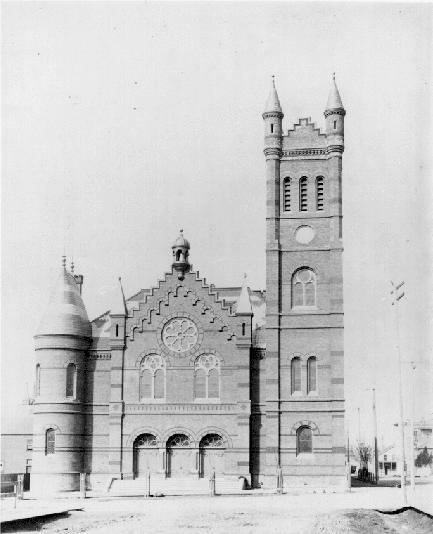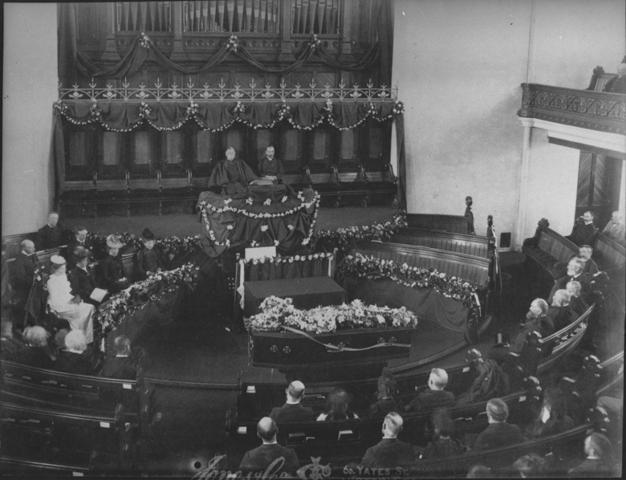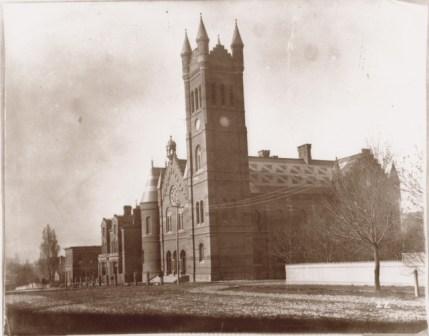
The 1890 Church
The need for a new church building was driven largely by the success of the dynamic preaching of the Rev P. Macfarlane McLeod. By 1888 the congregation had grown to almost 400 and the original church was simply too small. A building committee was formed chaired by John RobsonJohn Robson was a highly active, early member of St Andrew's and later Premier of BC. At the time Robson was the editor of the British Colonist and a long time elder of the church. By June 19th, a site had been acquired at the corner of Douglas and Broughton at a cost of $7,000 largely because it was less expensive than other options considered. Although the city was going through tough economic times, the church had some assets at its disposal including the old church, a hall on Broughton Street and two manses. The church also had a small group of active members including Robson, Robert DunsmuirWas an early but inconsistent member of St Andrew's and a coal mine founder. and R.P. RithetMr. Rithet was one of the wealthiest residents of BC who were among the wealthiest men in the city.
The building committee selected Leonard Butress Trimen, a prominent architect recently arrived from England, to prepare a design that would, in both scale and grandeur, stand out in the community. His design, referred to as a Scotish Baronial Style, was originally to have been completed in stone at an estimated cost of $40,000. Given the difficult economic circumstances of the day, the management committee recommended that work not commence until two thirds of the money had been secured. By November final plans had been approved by the congregation and trustees had been appointed for the new property, including Robert DunsmuirWas an early but inconsistent member of St Andrew's and a coal mine founder. and John RobsonJohn Robson was a highly active, early member of St Andrew's and later Premier of BC.(1) By January 1889, subscriptions totalled almost $13,000 including $1000 raised by the Ladies Aid Society and a similar amount by the Young Peoples Society. It was hoped that the sale of existing property would cover most of the balance. (2)
Not deterred by the obvious shortfall in funds, they asked for bids for construction. When the lowest bid came in at $48,000, new tenders were called substituting brick for the more expensive stone of the original plan. The congregation approved the plan and the cornerstone was laid in a stirring Masonic ceremony on March 7, 1889. Politicians and members of the local clergy spoke and the band of C Battery the Regiment of Canadian Artillery from Work Point barracks provided music.(3)
During construction, fund raising efforts continued led as usual by the ladies of the congregation. The Daily Colonist of November 21st reports on the St Andrew's Bazaar organized by the ladies of the church being held over for a second night. Individual members were asked to commit to regular payments over a two year period starting in January 1889.
The final inspection of the building was completed on October 12th and the formal opening and dedication ceremony held on January 12th 1890. The new kirk building was reportedly the fourth church in North America to be equipped with electric lights. At the time, the lights themselves were leased along with the electric power at a cost of $200 per quarter, a very substantial sum in 1890.
Although you will read of a period of considerable financial difficulty following the death of the Honorable John RobsonJohn Robson was a highly active, early member of St Andrew's and later Premier of BC, the mortgage on the building was retired in time for the 50th anniversary of the congregation in 1916.
Sources:
(1) Original floor plan
(2) The Kirk That Faith BuiltThe Kirk That Faith Built: St. Andrew's on Douglas Street, 1890-1990. Published by the Session of St. Andrew's Presbyterian Church. Morriss Printing Company, Victoria, 1989. p 27-28
(3) The Daily Colonist Mar 8, 1889 p 4



